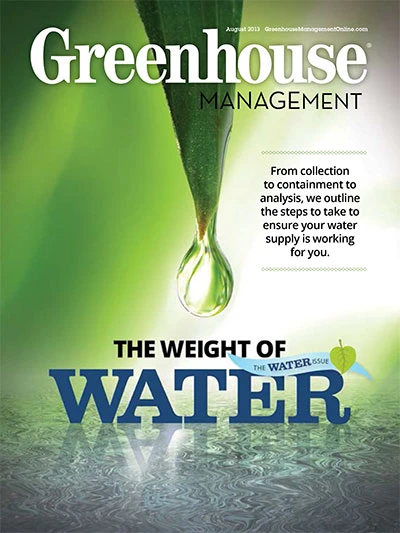The late great business guru Steven Covey believed that we should pay more attention to the important things of running a business and not get so caught up in putting out fires all day.
One of the most important — and perhaps overlooked — aspects of an ornamental greenhouse operation is water analysis. When our water supply is askew due to high alkalinity, salts, high or low pH or other factors that could be easily managed, it can result in a lot of time wasted wrestling with plant problems when we should be tending to other business.
“It’s one of those management things you need to do,” says Jim Robbins, extension specialist/professor, University of Arkansas Division of Agriculture. “It (water testing) is low-cost and pretty straightforward. Sadly, over the past 15 years, I have been surprised at the number of greenhouse businesses that have started that did not perform due diligence about the quantity and quality of their water. This should almost be one of the first things a plant business does moving forward.”
|
Pour Thru method The Pour Thru method is the simplest method for obtaining a solution sample from container media, says Neil Mattson. An advantage of this method is that you are simply collecting a leachate from each container and you do not need to directly sample container media and disturb the plant. Measurements tend to vary quite a bit between containers, so it is recommended that you take measurements from five to 10 containers and use the average value.
|
Testing the waters
While it’s important to monitor water quality for the day-to-day operations of a greenhouse, it’s critical to test the water before you buy property for a greenhouse or if you are expanding your operations, says Robbins.
“Unfortunately, a lot of people purchase property and are thinking about greenhouses, benches, all these things, when they should be thinking about the quantity and quality of their water,” he says. “We’re not making shoes in a factory — we’re growing plants.”
Robbins says once you’ve signed the papers for the property, corrective action can be expensive. Possible problems can include not enough water, very expensive water, high salinity and high alkalinity. Not all of these problems are insurmountable, he asserts, but people should have a “baseline” of information about their water supply, whether it be from a well or a municipal water facility.
There are many factors that affect water quality and quantity, according to Robbins, who works and farms in Arkansas and who is passionate about water. For instance, water quantity is a huge issue out West. Robbins says changes are occurring in aquifers due to drought and fracking and other demands on this valuable resource. He also notes that water analysis can change from season to season as a result of different weather events, including droughts and floods, necessitating the need to test your water at least annually.
When testing the water from its source, which Robbins says should be done by a professional lab, there are a number of things to be on the lookout for, including high salinity, high or low pH, and alkalinity, the latter being different from high pH (or alkaline), according to Neil Mattson, PhD, associate professor and floriculture extension specialist, Department of Horticulture, Cornell University. He says problems with high alkalinity pop up in upstate New York, the Midwest and also out West. High alkalinity can be remedied by choosing high-ammonium nitrogen for tanks; if the alkalinity is through the roof, you may have to consider an acid injection, he says.
“If they know that their alkalinity is high, they can work with a fertilizer supplier or cooperative extension and see if they should use an acid injection,” says Mattson. As most growers know, a balanced pH is also important; most floral crops do well at a pH between 5.5 and 6.5, but there are some exceptions (see pH guidelines sidebar, page 22).
Mattson says another factor to consider is the fluoride coming from municipal water supplies. A high concentration of fluoride might be okay for your teeth, but it can cause aesthetic damage to some floral crops, particularly freesia, spider plant (Chlorophytum), maranta and dracaena. Mattson says it is difficult to correct the situation if a municipality has added fluoride, though increasing the pH of the water can help.
Whether there is fluoride or not in the city supply, Mattson says it is best to befriend these folks so they’ll let you know when there are changes occurring to the supply.
Calcium and magnesium can be assumed to be in a water supply, but that isn’t always the case, say the experts. A lab test can signal if you need to compensate for the lack of these minerals, which can also change over time. The solution to this problem would be simply adding these minerals into your feeding tanks.
Check with your local extension office for laboratories to which you can send your water sample for analysis.
Robbins advises collecting the sample in a clean plastic bottle, and make sure you indicate that you’re going to be using the water to irrigate ornamental crops in a greenhouse.
Test — and test again Water analysis is also important to the day-to-day operations of a greenhouse, says Mattson, mostly because injectors can become plugged and changes can occur in the water supply. High levels of salt commonly appear in a water analysis, and they could be coming from your water supply source or from overfertilizing or problems with your equipment. Mattson suggests testing water every other week with an inexpensive (less than $100) electrical conductivity (EC) meter. This meter will check for salts, pH and alkalinity.
An effective way to see how well your fertilization program is working is to pour distilled water through one of your container plants and then test the water with an EC meter, states Mattson (see the “Pour Thru method” sidebar, page 21).
“If salt levels get too high, it means over time it will burn roots, it can burn leaf tissue,” says Mattson. “If the grower knows total salts they can look at leaching practices.” He says the purer the water in the sample, the less you have to do the leaching step to your container plants, which simply involves flushing the salts that are caused by nitrogen-based fertilizers through the growing containers.
If you manage your water well, your task as a greenhouse manager and grower will get a whole lot easier. Perhaps you can even take a little time off this summer.
 |
Neil Moran is a horticulturist and regular contributor to Greenhouse Management magazine. Visit his website at www.neilmoran.com.
For more: www.uaex.edu/Other_Areas/publications/PDF/FSA-6061.pdf

Explore the August 2013 Issue
Check out more from this issue and find your next story to read.
Latest from Greenhouse Management
- North Carolina Nursery & Landscape Association announces new executive vice president
- Plant Development Services, Inc. unveils plant varieties debuting in 2025
- Promo kit available to celebrate first National Wave Day on May 3
- Applications now open for American Floral Endowment graduate scholarships
- Endless Summer Hydrangeas celebrates 20 years with community plantings
- Invest in silver
- Garden Center magazine announces dates for 2025 Garden Center Conference & Expo
- USDA launches $2 billion in aid for floriculture growers







